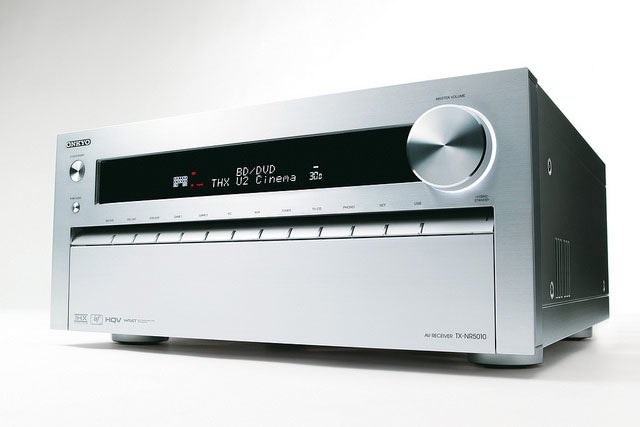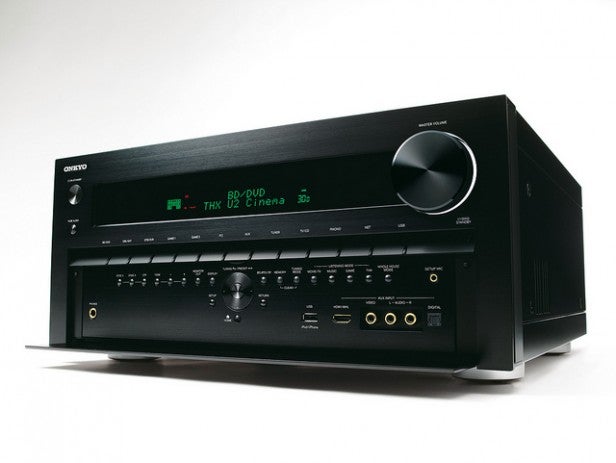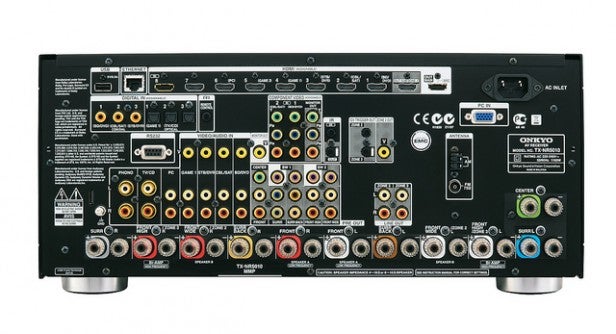Onkyo TX-NR5010 Review
Onkyo TX-NR5010
Onkyo’s fantastic flagship amp will blow you away.

Sections
- Page 1 Onkyo TX-NR5010 Review
- Page 2 Features Review
- Page 3 Operation, Performance and Verdict Review
Verdict
Pros
- Thunderous home cinema sound
- Lengthy feature list
- Excellent build quality and design
Cons
- Expensive
- Remote a little cluttered
- Aggressive sound might not be to all tastes
Key Specifications
- Review Price: £3000.00
- 9.2-channel AV receiver
- 220W per channel
- THX Ultra 2 Plus certified
- Spotify, internet radio & DLNA music streaming
- Dolby Pro Logic IIz, DTS Neo:X, Audyssey DSX
Introduction
The TX-NR5010 is Onkyo’s latest flagship AV receiver, a frighteningly feature-packed behemoth designed to send home cinephiles to heaven and back. It’s a 9.2-channel THX Ultra 2 Plus affair, with a spec sheet that reads like a home cinema glossary and a whopping power rating of 220W per channel. Naturally this sort of power and functionality doesn’t come cheap, but enthusiasts with the budget for a high-spec receiver could well find it money well spent.
Onkyo TX-NR5010 – Design
At 29kg the unit is ridiculously heavy and styled in a no-nonsense but tasteful fashion, with a business-like black finish (also available in silver) and clean straight lines. At 337mm high it’ll hog a fair chunk of cabinet space, but a beast like this really belongs in a dedicated cinema room. Build quality is sensational – the thick anti-resonant aluminium panels give it an almost industrial solidity, while the ventilation holes on the firmly-bolted top panel offer a tantalising glimpse of the heavyweight electronics inside. These include a huge toroidal transformer for the Three-Stage Inverted Darlington Circuitry, aided by separate transformers for audio and video processing.
The fascia is blissfully free from clutter thanks to a large flap that hides all the front sockets and buttons (apart from source selection, power and Pure Audio) but naturally there’s a prominent volume dial, accentuated by a turquoise light, alongside a large LED display panel that’s easy to read from the sofa. Under the flap is a wealth of buttons for controlling the unit’s many functions, including listening mode keys and a direction pad for up-close menu control. There’s also a row of auxiliary inputs including HDMI, USB (for direct iPod/iPhone connection), optical digital audio, composite video and analogue stereo.
Onkyo TX-NR5010 – Connections
On the back it offers every type of connection you could ever need and lots of them, most notable of which are the eight HDMI inputs (that’s nine including the one on the front) and two outputs, which can send 1080p pictures to a second display or zone. Naturally they are primed for 3D and Audio Return Channel, but the front port also supports Mobile High-Definition Link, a way of watching HD videos from smartphones, camcorders and other portable devices. You can switch between HDMI inputs onscreen using InstaPrevue, a nifty picture-in-picture feature.
There are plenty of inputs for audio sources too – seven sets of analogue stereo inputs (including one for a turntable), six digital audio inputs (three optical, three coaxial), 11.4-channel pre-outs (with two sub outputs) and two sets of phono outs for multiroom use (Zones 2 and 3).
You also get plenty of video sockets including two sets of component video and four composite video ports (with one output for each). Rounding up the selection are a PC input, a second USB port, Ethernet and RS-232 ports, FM/AM radio antenna inputs, 12V trigger outs for zones 2 and 3, zone 2 composite video out and IR in/out.

